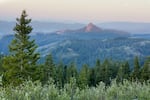
The Cascade-Siskiyou National Monument in Southern Oregon.
Bob Wick / BLM
Seven years ago, three groups separately sued the federal government over the expansion of the Cascade-Siskiyou National Monument: Murphy Company, an Oregon-based timber company; the Association of O&C Counties, a group advocating for timber management; and the American Forest Resource Council, an advocacy group for the timber industry. The AFRC and AOCC lawsuits were later consolidated.
That 48,000-acre increase was designated by President Barack Obama in early 2017.
The groups argued that the decision limited logging on land where it should have been allowed to occur. They cited the 1937 O&C Act, which designated federal forestland in Oregon to be set aside and used for local governments to fund public services through forest production. President Obama used the Antiquities Act of 1906 to expand the monument, which legally protects cultural and natural resources of historic or scientific interest on federal lands.
“With the stroke of a pen, and with no environmental analysis or public process, President Obama nullified a federal law and directed the BLM to ignore Congressional direction on how to manage the O&C lands in Southwest Oregon,” AFRC wrote in a press release earlier this month.
Murphy Company made similar arguments, writing, “The question presented is whether the Antiquities Act authorizes the President to declare federal lands part of a national monument where a separate federal statute reserves those specific federal lands for a specific purpose that is incompatible with national-monument status.”
But on Monday, the Supreme Court declined to hear both cases, although Justices Neil Gorsuch and Brett Kavanaugh said they would have granted the petition to hear the cases.
In a statement, AFRC President Travis Joseph said they were “disappointed” by the Supreme Court’s decision.
Kristen Boyles, the lead attorney for the groups defending the monument, described her reaction.
“Frankly, it’s one of relief, that we have gotten to the end of these challenges to monument expansion, and that the Cascade-Siskiyou National Monument is now protected for all of us as we go forward,” she said.
In earlier rulings, the D.C. Circuit Court had already ruled against the AFRC, while the Ninth Circuit had ruled against Murphy Company.
Since the Supreme Court won’t hear the cases, those earlier rulings, and the expansion of the monument, will stand.
“As of this morning, the courts have now made abundantly clear. The timber industry’s selectively self-serving reading, narrow reading, myopic reading, of the O & C Act is, and always has been, wrong,” said Dave Willis, chair of the Soda Mountain Wilderness Council, which defended the monument.
“Both appellate courts got it right,” the groups supporting current monument status argued in their brief. “They applied settled statutory interpretation principles to conclude that the O&C Act contains broad, multi-purpose management directives, and that the monument proclamation’s provisions fit comfortably alongside those directives.”
Attorneys for AFRC and Murphy Company did not respond to requests for comment.
These cases drew attention from a variety of groups, with friend of the court briefs filed by the Public Lands Council, National Cattlemen’s Beef Association, Pacific Legal Foundation, Roseburg Area Chamber of Commerce and NFIB Small Business Legal Center, Inc., National Association of Home Builders of the United States, Arizona Farm Bureau Federation and Representative Cliff Bentz and other Congress members.
“While disappointing, this decision was not a surprise. We knew getting our case before the Supreme Court would be very difficult,” AOCC Executive Director Doug Robertson said in a statement.
The Cascade-Siskiyou National Monument was originally designated by President Bill Clinton in 2000. It’s located at the intersection of the Klamath, Siskiyou and Cascade mountain ranges and is known for its biological diversity.